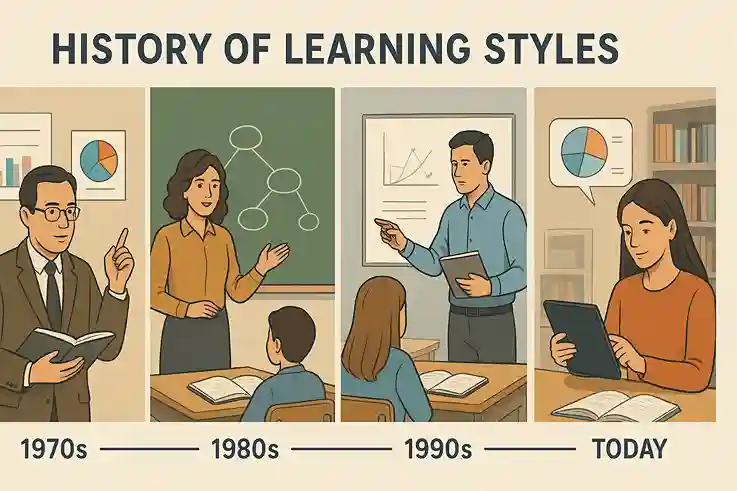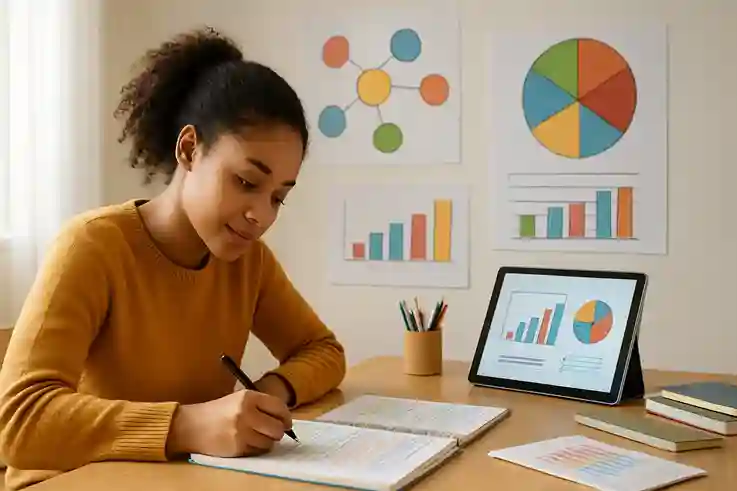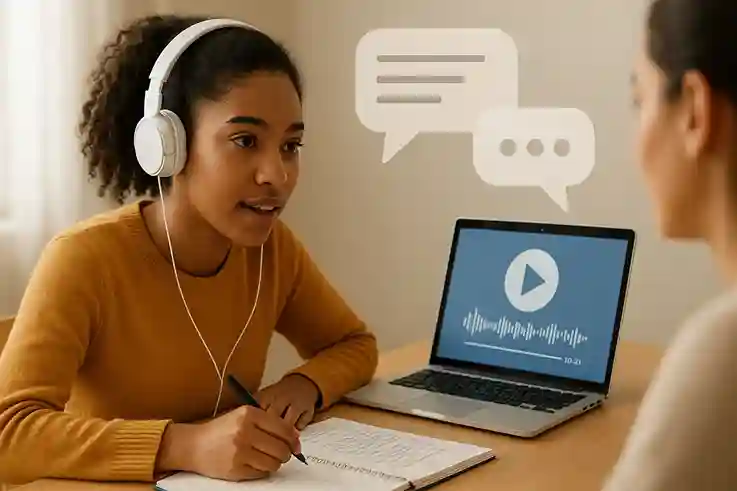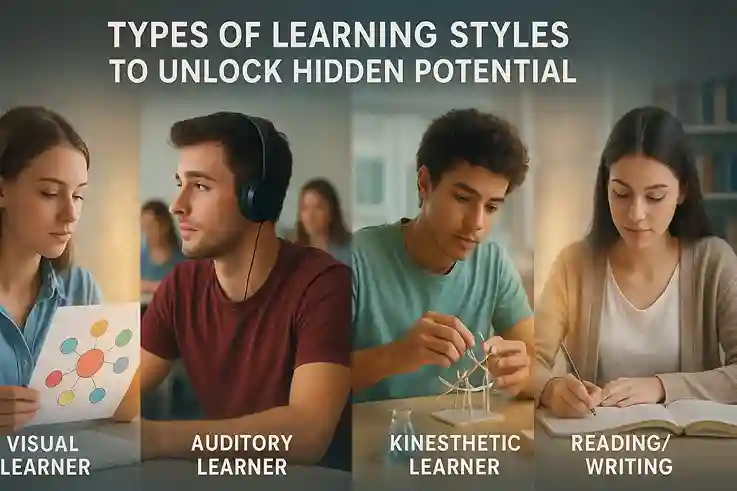Types of Learning Styles
Types of learning styles shape how people absorb, process, and retain knowledge. Each person has unique preferences that influence how well they understand and remember information. By recognizing these differences, individuals can unlock hidden potential that often goes unnoticed in traditional learning environments.
Understanding learning styles matters for everyone. Students can improve study habits, teachers can design more effective lessons, and lifelong learners can discover strategies that keep them motivated. Exploring these styles is not just about education—it is about finding personal strengths and building confidence in learning.
What Are Learning Styles?
Learning styles are the different ways people prefer to absorb, process, and remember information. They explain why one method works well for some but not for others.

A Brief History
The concept of learning styles rose to prominence in the 1970s. Psychologists and educators began exploring why students responded differently to the same lessons. Early theories suggested that matching instruction to a learner’s preferred style could improve comprehension and retention.
In the 1980s, the idea spread widely across schools and training programs. Models such as visual, auditory, and kinesthetic learning became common terms in education. Teachers were encouraged to design lessons that addressed multiple styles to reach every student.
By the 1990s, learning styles became a mainstream topic. Countless workshops, books, and tests were created to help people identify their style. Many schools adopted these approaches, hoping to boost performance and engagement.
However, researchers soon raised questions. Studies showed mixed evidence on whether teaching to a specific style truly improved results. Some argued that effective learning depends more on practice, context, and motivation than on matching styles.
Despite the debate, the idea of learning styles remains deeply rooted in education and personal development. Many learners still find value in knowing their preferences, even if research suggests a balanced approach may work best. The concept continues to inspire both students and teachers to reflect on how learning really happens.
Why They Matter
Helping Students
Learning styles help students discover study methods that feel natural. Visual learners may benefit from charts, while auditory learners thrive with discussions. This awareness makes study sessions more effective and less stressful.
Guiding Teachers
Teachers can use learning styles to design engaging lessons. Mixing visuals, discussions, and hands-on activities keeps students involved. This variety ensures that no single group is left behind.
Supporting Lifelong Learners
For lifelong learners, understanding styles brings valuable self-awareness. It encourages experimentation with new methods and strategies. Over time, this adaptability unlocks hidden potential and builds confidence in learning.
Types of Learning Styles Explained
Learning styles are often grouped into four main categories. Over time, other styles have also been suggested to reflect the many ways people learn.

Visual Learners
Visual learners absorb information best when it is presented in a visual format. Pictures, charts, and diagrams make complex ideas easier to understand. Colors, shapes, and patterns help them organize information in a way that sticks.
They often prefer study tools such as color-coded notes, mind maps, or infographics. These resources allow them to “see” how concepts connect. For instance, when learning about history, a timeline can be far more effective than long blocks of text.
Visual learners also benefit from symbols, flashcards, and even drawing sketches of ideas. Turning abstract information into images strengthens memory and understanding. Because they process details visually, they may struggle with purely spoken instructions unless supported by written or illustrated material.
When teachers or students use visual strategies, learning becomes clearer, faster, and more engaging for this group.
Visual Learners at a Glance
| Aspect | How It Helps Visual Learners | Example |
|---|---|---|
| Best Tools | Diagrams, charts, mind maps | History timeline for major events |
| Note-Taking Style | Color-coded notes and highlights | Using different colors for key terms |
| Study Techniques | Infographics, flashcards, drawings | Sketching a science process |
| Strengths | Seeing patterns and connections | Spotting trends in data charts |
| Challenges | Long verbal explanations | Forgetting details from spoken lectures |
| Tips for Success | Turn words into visuals | Convert notes into a flowchart |
Auditory Learners

Auditory learners thrive on sound and spoken information. They absorb knowledge best when they hear it explained, repeated, or discussed. Conversations, debates, and group activities play a powerful role in helping them understand concepts.
They often perform well in classrooms where lectures and verbal instructions are common. Listening to recordings, podcasts, or even their own voice notes can make studying more effective. Rhythm and repetition also help. For example, a student may remember math formulas by turning them into short songs or chants.
Because they rely heavily on sound, auditory learners may find it harder to follow long written instructions without guidance. Reading aloud or explaining ideas to others often strengthens their comprehension.
When supported with spoken methods, auditory learners gain confidence and connect more deeply with the material.
Auditory Learners at a Glance
| Aspect | How It Helps Auditory Learners | Example |
|---|---|---|
| Best Tools | Lectures, podcasts, recordings | Listening to a recorded class lesson |
| Note-Taking Style | Reading notes aloud, verbal review | Repeating definitions out loud |
| Study Techniques | Group discussions, Q&A sessions | Explaining a topic to a study partner |
| Strengths | Remembering spoken details, active listening | Retelling a story after hearing it once |
| Challenges | Dense reading without explanation | Struggling with silent independent study |
| Tips for Success | Use rhythm, songs, or chants | Turning formulas into rhymes |
Kinesthetic Learners

Kinesthetic learners focus on movement and hands-on practice. They learn by doing rather than by simply watching or listening. Physical activity, touch, and direct interaction with materials keep them engaged and motivated.
These learners often struggle with long reading sessions or extended lectures. Sitting still for long periods can make concentration difficult. However, they excel in labs, workshops, or role-play activities where active participation is required.
For example, a kinesthetic learner might understand geometry better by physically building shapes. Handling objects, experimenting, or acting out scenarios makes abstract concepts concrete. Writing notes repeatedly, using gestures while studying, or moving around while reviewing also supports retention.
Because they connect learning with action, kinesthetic learners often display creativity and problem-solving skills in real-world situations. With the right strategies, their energy becomes a powerful learning tool.
Kinesthetic Learners at a Glance
| Aspect | How It Helps Kinesthetic Learners | Example |
|---|---|---|
| Best Tools | Hands-on activities, models, props | Building shapes to learn geometry |
| Note-Taking Style | Rewriting notes, doodling, sketching | Drawing diagrams while studying |
| Study Techniques | Role play, experiments, movement-based study | Acting out a historical event |
| Strengths | Creativity, practical application, active problem-solving | Excelling in science labs |
| Challenges | Long reading or lectures without activity | Losing focus in silent study sessions |
| Tips for Success | Add motion to study routines | Walking while reviewing notes |
Reading and Writing Learners

This group learns best through words on a page. They prefer structured text, detailed explanations, and written assignments. Lists, essays, and summaries feel natural and help them retain information effectively.
They enjoy note-taking and rewriting material to reinforce memory. Reading textbooks, creating outlines, and using written quizzes are strategies that support their learning. For example, a student may study science by writing detailed summaries and reviewing them repeatedly.
These learners often thrive in traditional classroom settings where reading and writing dominate. However, they may struggle in classes that rely too heavily on visuals or spoken instruction without written support. By turning information into structured notes, essays, or written reflections, reading and writing learners can transform even complex subjects into manageable content.
Reading/Writing Learners at a Glance
| Aspect | How It Helps Reading/Writing Learners | Example |
|---|---|---|
| Best Tools | Textbooks, notes, essays, written tests | Reading a chapter and summarizing it |
| Note-Taking Style | Detailed outlines, lists, rewriting notes | Creating study guides from class notes |
| Study Techniques | Journals, essays, reading aloud | Writing practice essays for revision |
| Strengths | Clear organization, strong vocabulary, written expression | Excelling in essay-based exams |
| Challenges | Limited engagement with only visuals or audio | Struggling with diagram-only instructions |
| Tips for Success | Convert visuals into words | Writing explanations for charts or graphs |
Logical Learners

Logical learners rely on patterns, reasoning, and structured analysis. They prefer information that is organized and follows clear rules. Numbers, data, and cause-and-effect relationships make learning easier for them.
They enjoy solving puzzles, working with data, and breaking down systems step by step. Strategy games, coding, and problem-solving activities often bring out their strengths. A logical learner might excel at programming, math, or science because these fields reward structured thinking.
However, they may struggle when lessons feel vague or unstructured. They learn best when given clear frameworks, formulas, or logical steps to follow. By focusing on order and reasoning, logical learners turn complex subjects into simple, understandable patterns.
Logical Learners at a Glance
| Aspect | How It Helps Logical Learners | Example |
|---|---|---|
| Best Tools | Data charts, formulas, flowcharts | Using a flowchart to study processes |
| Note-Taking Style | Organized outlines, numbered lists | Numbering steps in a math problem |
| Study Techniques | Problem sets, puzzles, coding | Practicing with brain-teasers |
| Strengths | Analytical skills, critical thinking | Breaking down complex problems |
| Challenges | Abstract or unstructured lessons | Struggling with open-ended tasks |
| Tips for Success | Find patterns in material | Turn text into step-by-step rules |
Social Learners

Social learners perform best in group settings where interaction drives understanding. They enjoy teamwork, collaborative discussions, and problem-solving with peers. For them, learning becomes stronger when ideas are shared, debated, and explained out loud.
They often thrive in classrooms that encourage participation. Study groups, role-playing, and peer teaching work well for this style. A social learner may remember details better after discussing them with classmates than by studying alone.
However, they may struggle with tasks that require long periods of independent work. Without interaction, focus and motivation can decrease. To succeed, social learners benefit from combining group study with brief individual review sessions.
Social Learners at a Glance
| Aspect | How It Helps Social Learners | Example |
|---|---|---|
| Best Tools | Group study, role play, teamwork | Discussing a novel in a study circle |
| Note-Taking Style | Shared notes, brainstorming lists | Creating a group mind map |
| Study Techniques | Peer teaching, Q&A sessions | Explaining concepts to a partner |
| Strengths | Communication, collaboration, memory through interaction | Remembering details after debates |
| Challenges | Independent study without support | Losing focus when studying alone |
| Tips for Success | Balance group work with solo review | Summarize group sessions into notes |
Solitary Learners

Solitary learners prefer to work alone and reflect deeply on what they study. They are usually self-motivated and comfortable setting their own pace. Independent environments allow them to focus without distractions.
These learners often keep journals, personal notes, or private study logs. Writing reflections or connecting ideas to personal experiences strengthens their memory. For example, a solitary learner may prefer studying quietly in a library instead of joining a group study session.
They thrive when given space to think, plan, and analyze on their own. However, too much isolation can sometimes limit exposure to new perspectives. To grow, solitary learners benefit from occasional group discussions while keeping independence as their main approach.
Solitary Learners at a Glance
| Aspect | How It Helps Solitary Learners | Example |
|---|---|---|
| Best Tools | Journals, personal notes, self-tests | Writing a study diary |
| Note-Taking Style | Private reflections, detailed notes | Keeping a personal vocabulary log |
| Study Techniques | Independent research, self-paced study | Studying quietly in a library |
| Strengths | Focus, self-motivation, deep reflection | Analyzing topics in detail alone |
| Challenges | Limited collaboration, fewer perspectives | Missing group discussions |
| Tips for Success | Balance solo work with group input | Join a discussion after self-study |
Together, these categories show that learning is not one-size-fits-all. Most people use a mix of styles, shifting depending on the subject or situation.
The U.S. Department of Agriculture’s National Institute of Food and Agriculture (USDA NIFA) offers a concise guide on learning styles.
Do Learning Styles Really Work?
The Ongoing Debate
The idea of learning styles has been discussed for decades in classrooms and research studies. Many educators believe that adapting lessons to fit a learner’s preferred style can improve understanding and retention. The reasoning is simple—when information is presented in a way that feels natural, learning becomes less stressful and more engaging.
Students also report that they feel more confident when they use methods that match their preferences. A visual learner may remember details more easily with diagrams, while an auditory learner may grasp ideas faster through discussions. This sense of comfort often encourages persistence and motivation.
Still, the question remains whether matching styles directly leads to better performance, or if the real benefit lies in boosting confidence and interest.
What Research Shows
Studies on learning styles have produced mixed evidence. While the theory suggests that matching teaching methods to a learner’s style should improve performance, results do not always support this claim. Some research shows little to no difference in outcomes when lessons are tailored to visual, auditory, or kinesthetic preferences.
Instead, many findings suggest that learning success depends more on practice, prior knowledge, and personal motivation. For example, a motivated student may succeed regardless of whether material is presented through text, speech, or visuals. This highlights that effort and engagement often outweigh style-based strategies.
Critics also argue that the learning styles model oversimplifies a complex process. Human learning involves memory, environment, and emotional factors that cannot be explained by a single preference. Overemphasizing styles may even limit students, making them believe they can only learn one way.
Still, the research does not dismiss learning styles entirely. While they may not guarantee stronger test scores, they can increase self-awareness and make students more open to exploring new strategies.
The Practical Value
Supporters argue that learning styles still provide meaningful value. When students identify their preferred ways of learning, they often feel more confident and motivated. This self-awareness encourages them to take charge of their education and explore strategies that feel natural.
Even if research questions the direct effectiveness of style-based teaching, the awareness itself can be powerful. Students who know their strengths tend to develop stronger study habits. They also experiment with methods that make learning less stressful and more enjoyable.
For teachers, learning styles can serve as a starting point to design more engaging lessons. By combining visual, auditory, and hands-on activities, classrooms become more inclusive. For lifelong learners, this reflection can spark personal growth and unlock hidden potential.
A Flexible Approach
The best path is adaptability. Learners benefit when they experiment with multiple strategies instead of relying on one preferred style. A student may use diagrams for science, discussions for history, and practice problems for math. This variety strengthens learning and builds resilience.
Teachers can also embrace flexibility. By mixing visuals, discussions, and hands-on activities, they create lessons that reach every type of learner. A blended approach keeps classrooms dynamic and prevents students from feeling limited by labels.
Flexibility does more than improve academic results. It helps learners build broader skills, adapt to new challenges, and approach problems with creativity. In a world where information comes in many forms, adaptability ensures deeper understanding and long-term growth.
How to Identify Your Learning Style
Quick Self-Reflection
Start with simple questions:
- Do you remember better when you see pictures or read notes?
- You prefer listening to explanations or working with your hands?
- Do you enjoy studying alone or discussing with friends?
These clues reveal natural tendencies.
Using Quizzes and Assessments
Many online quizzes can guide learners toward their preferred style. They are not perfect, but they often reveal useful insights. A quiz may highlight if you lean toward visuals, sounds, or hands-on practice.
Teachers can also notice patterns in the classroom. Some students take detailed notes, others ask for group work, while a few thrive in practical activities. These cues often point to how each learner engages best with new information.
Building Self-Awareness
The real goal is not to lock yourself into a single category. Learning styles are guides, not rules. Self-awareness allows learners to see their strengths and recognize areas that may need improvement. For example, a visual learner can still benefit from discussions, and an auditory learner can grow through hands-on practice.
Once learners know their natural tendencies, they can begin testing new strategies instead of relying on one method. This flexible mindset keeps learning fresh and adaptable. Over time, balance leads to stronger skills, deeper understanding, and greater confidence. In the end, self-awareness becomes the key to unlocking hidden potential and making learning a lifelong strength.
Unlocking Hidden Potential Through Styles
Learning styles can guide you toward stronger study habits, but the real power comes from flexibility. Mixing strategies allows learners to reach beyond comfort zones and explore new strengths.
Practical Tips to Unlock Potential
Mix strategies
Relying on only one method can limit learning growth. Blending different approaches creates stronger and more lasting understanding. For example, a student studying history could first review a timeline to see events visually, then discuss those events with peers to process them socially, and finally build a model or draw a map for hands-on practice. Each layer activates different parts of the brain, making the material easier to absorb, recall, and connect with real-world contexts.
Explore strengths
Your natural preferences are a powerful foundation, but they should not become a boundary. Start by leaning into what feels comfortable—like creating colorful charts if you’re a visual learner, or recording lectures if you learn best by listening. These methods build confidence and make studying less stressful. Over time, you can expand by adding new techniques that challenge your weaker areas. By exploring strengths while staying open to growth, learning becomes both enjoyable and transformative.
Adapt to goals
Not every subject benefits from the same learning method. The most effective learners adjust their approach based on the goal. For instance, history facts may stick better with charts, maps, or timelines that show events clearly. On the other hand, building communication skills works best through role-play, discussions, or real-life practice. By matching strategies to the task at hand, learners avoid frustration and gain practical mastery. Flexibility ensures that knowledge moves beyond memorization into true understanding and application.
Experiment often
Learning is not one-size-fits-all, and what works today may not work tomorrow. The key is to stay curious and test different approaches. Try replacing passive reading with drawing diagrams, recording your own voice notes, or joining a study group. Notice what methods improve focus and make ideas stick. Over time, experimentation reveals patterns—some strategies will consistently boost retention, while others may only help in specific subjects. This trial-and-error process keeps learning fresh, flexible, and deeply effective.
This adaptability boosts both performance and confidence. Learners discover they are capable of more than they thought. Over time, experimenting with styles builds resilience, creativity, and lasting growth.
FAQs on Types of Learning Styles
Conclusion: Types of Learning Styles
Learning styles are more than just labels—they are starting points for self-discovery. While research debates their direct impact, one thing remains clear: understanding your preferences builds confidence, focus, and motivation. The real key is not locking yourself into a single category but staying flexible. By mixing strategies, exploring strengths, and adapting methods to your goals, you expand your ability to learn in any situation.
Whether you’re a student, professional, or lifelong learner, experimenting with different approaches can reveal hidden potential you didn’t know you had. In the end, success comes not from following one style but from embracing adaptability as a lifelong skill.
💡 Now it’s your turn: Which learning style do you connect with most?
Share your thoughts, experiences, or tips in the comments—We will love to hear how you unlock your potential through learning.

Amber Hexshot is a creative blogger with a specialty in home décor, where she shares fresh ideas on design, styling, and creating inviting spaces. With a keen eye for detail and a love for transforming everyday rooms into inspiring environments, she enjoys helping readers bring beauty and personality into their homes. Beyond décor, Amber also explores other topics such as lifestyle, travel, and personal growth, offering a wide variety of content that resonates with her audience.
When she’s not writing, Amber loves visiting art galleries, experimenting with DIY projects, and discovering unique design trends from around the world. Her approachable tone and practical advice make her blogs both inspiring and easy to follow.


